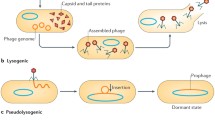Abstract
We have recently developed a novel bacteriophage-protection system for Lactococcus lactis, based on a two-component genetic ‘trap’. An inducible promoter from a lytic bacteriophage is used to activate a lethal gene after infection, killing the host cell and halting phage proliferation. To expand the potential use of this novel defense strategy, promoters specific to any particular phage of interest must be available for fusion to a universal death gene. A method to localize regulated promoters within the context of the total phage genome was evaluated. The ‘capping’ activity of the vaccinia virus guanylyltransferase was exploited to label newly synthesized mRNA extracted from infected cells at sequential time points over the course of a phage infection. The labeled mRNAs were then used as probes in Southern hybridization reactions to identify restriction fragments in the phage genome where new transcripts were initiated during progression of the phage lytic cycle. This method has been used successfully in our laboratory to map the general location of a number of inducible promoters on the genomes of bacteriophages attacking lactic acid bacteria. Once identified and cloned, small fragments encoding inducible promoters can be partially sequenced and primer extension reactions carried out on phage RNA, isolated over the course of an infection, to pinpoint the precise location of the promoter. In this study, we illustrate the use of the capping method to map the phage-inducible promoter on the genome of the lactococcal bacteriophage sk1. This approach provides a rapid and efficient means to identify promoter regions on the genomes of relatively uncharacterized phages. These promoters can then be used in a variety of applications, including phage-triggered defenses and inducible gene expression systems.
Similar content being viewed by others
References
Chandry PS, Davidson BE, Hillier AJ (1994). Temporal transcription map of Lactococcus lactis bacteriophage sk1. Microbiology 140: 2251–2261.
Chandry, PS, Moore, SC, Boyce, JD, Davidson BE, Hillier AJ (1997). Analysis of the DNA sequence, gene expression, origin of replication, and modular structure of the Lactococcus lactis lytic bacteriophage sk1. Mol Microbiol 26: 49–64.
Cho N-Y, Choi M, Rothman-Denes LB (1995). The bacteriophage N4-coded single-stranded DNA-binding protein (N4SSB) is the transcriptional activator of Escherichia coli RNA polymerase at N4 late promoters. J Mol Biol 246: 461–471.
Djordjevic GM, Klaenhammer, TR (1996). Positive selection, cloning vectors for Gram-positive bacteria based on a restriction endonuclease cassette. Plasmid 35: 37–45.
Djordjevic GM, Klaenhammer TR (1997). Bacteriophage-triggered defense systems: phage adaptation and design improvements. Appl Environ Microbiol 63: 4370–4376.
Djordjevic GM, O'sullivan DJ, Walker SA, Conkling MA, Klaenhammer TR (1997). A triggered-suicide system designed as a defense against bacteriophages. J Bacteriol 179: 6741–6748.
Elliott T, Geiduschek EP (1984). Defining a bacteriophage T4 late promoter: absence of ‘–35’ region. Cell 36: 211–219.
Farrell RE Jr (1993). Practical nucleic acid hybridization. In: RNA methodologies, pp 191–203. Academic Press, Inc.
Gasson MJ (1983). Plasmid complements of Streptococcus lactis NCDO712 and other lactic streptococci after protoplast-induced curing. J Bacteriol 154: 1–9.
Haynes LL, Rothman-Denes LB (1985). N4 virion RNA polymerase sites of transcription initiation. Cell 41: 597–605.
Hill C, Pierce K, Klaenhammer TR (1989). The conjugative plasmid pTR2030 encodes two bacteriophage defense mechanisms in lactococci, restriction modification (R+/M+) and abortive infection (Hsp+). Appl Environ Microbiol 55: 2416–2419.
Itoh N, Mizumoto K, Kaziro Y (1984). Messenger RNA guanylyltransferase from Saccharomyces cerevisiae. J Biol Chem 259: 13923–13929.
Mizumoto K, Lipman F (1979). Transmethylation and transguanylylation in 5′-RNA capping system isolated from rat liver nuclei. Proc Natl Acad Sci USA 76: 4961–4965.
Monroy G, Spencer E, Hurwitz J (1978a). Purification of mRNA guanylyltransferase from vaccinia virions. J Biol Chem 253: 4481–4489.
Monroy G, Spencer E, Hurwitz J (1978b). Characteristics of reactions catalyzed by purified guanylyltransferase from vaccinia virus. J Biol Chem 253: 4490–4498.
Monsalve M, Mencia M, Rojo F, Salas M (1995). Transcription regulation in Bacillus subtilis phage φ29: expression of the viral promoters throughout the infection cycle. Virology 207: 23–31.
Nuez B, Salas M (1993). Bacteriophage Nf DNA region controlling late transcription: structural and functional homology with bacteriophage φ29. Nucleic Acid Res 21: 2861–2865.
O'sullivan DJ, Klaenhammer TR (1995). C LlaI is a bifunctional regulatory protein of the llaI restriction modification operon from Lactococcus lactis. In: Feretti JJ, Gilmore MS, Klaenhammer TR, Brown F (eds), Genetics of the streptococci, enterococci, and lactococci, vol 85: Dev Biol Stand, pp 591–595. Basel: Karger.
O'sullivan DJ, Zagula K, Klaenhammer TR (1995). In vivo restriction by LlaI is encoded by three genes, arranged in an operon with llaIM, on the conjugative Lactococcus plasmid pTR2030. J Bacteriol 177: 134–143.
O'sullivan DJ, Walker SA, West SG, Klaenhammer TR (1996). Development of an expression strategy using a lytic phage to trigger explosive plasmid amplification and gene expression. Bio/Technology 14: 82–87.
Parreira R, Valyasevi R, Lerayer ALS, Ehrlich SD, Chopin M-C (1996). Gene organization and transcription of a late-expressed region of Lactococcus lactis phage. J Bacteriol 178: 6158–6165.
Powell IB, Arnold PM, Hillier AJ, Davidson BE (1989). Molecular comparison of prolate-and isometric-headed bacteriophages of lactococci. Can J Microbiol 35: 860–866.
Raya RR, Kleeman EG, Luchansky JB, Klaenhammer, TR (1989). Characterization of the temperate bacteriophage φadh and plasmid transduction in Lactobacillus acidophilus ADH. Appl Environ Microbiol 55: 2206–2213.
Sambrook J, Fritsch EF, Maniatis, T (1989). Molecular cloning: a laboratory manual, Second edition. Cold Spring Harbor, NY: Cold Spring Harbor Laboratory.
Southern EM (1975). Detection of specific sequences among DNA fragments separated by gel electrophoresis. J Mol Biol 98: 503–517.
Stoddard SF, Howe MM (1989). Localization and regulation of bacteriophage Mu promoters. J. Bacteriol 171: 3440–3448.
Terzaghi BE, Sandine WE (1975). Improved medium for lactic streptococci and their bacteriophages. Appl Microbiol 29: 807–813.
Waterfield NR, Lubbers MW, Polzin KM, Le Page RWF, Jarvis AW (1996). An origin of DNA replication from Lactococcus lactis bacteriophage c2. Appl Environ Microbiol 62: 1452–1453.
Author information
Authors and Affiliations
Rights and permissions
About this article
Cite this article
Djordjevic, G.M., Klaenhammer, T.R. A method for mapping phage-inducible promoters for use in bacteriophage-triggered defense systems. Methods Cell Sci 20, 119–126 (1998). https://doi.org/10.1023/A:1009708906437
Issue Date:
DOI: https://doi.org/10.1023/A:1009708906437




